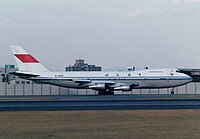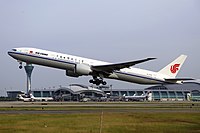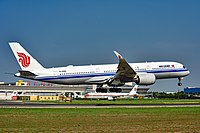Air China
 | |||||||
| |||||||
| Founded | 1 July 1988 | ||||||
|---|---|---|---|---|---|---|---|
| Hubs | |||||||
| Secondary hubs | |||||||
| Focus cities | |||||||
| Frequent-flyer program | PhoenixMiles | ||||||
| Alliance | Star Alliance | ||||||
| Subsidiaries |
| ||||||
| Fleet size | 500 | ||||||
| Destinations | 203[2] | ||||||
| Parent company |
| ||||||
| Traded as | |||||||
| Headquarters | Beijing Tianzhu Airport Industrial Zone, Shunyi District, Beijing, China | ||||||
| Key people | |||||||
| Employees | 65,000 (2023) | ||||||
| Website | www | ||||||
| Air China Limited | |||||||
|---|---|---|---|---|---|---|---|
| Simplified Chinese | 中国国际航空股份公司 | ||||||
| Traditional Chinese | 中國國際航空股份公司 | ||||||
| Literal meaning | China International Airlines, Company Limited by Shares | ||||||
| |||||||
| Alternative Chinese name | |||||||
| Simplified Chinese | 中国国际航空公司 | ||||||
| Traditional Chinese | 中國國際航空公司 | ||||||
| Literal meaning | China International Airlines Company | ||||||
| |||||||
| Air China | |||||||
| Simplified Chinese | 国航 | ||||||
| Traditional Chinese | 國航 | ||||||
| Literal meaning | National Airline | ||||||
| |||||||
Air China Limited (中国国际航空公司) is a major Chinese airline and is the flag carrier airline of the People's Republic of China. It is headquartered in Shunyi, Beijing. The airline offers both domestic and international flights to different destinations around China and the world.
The airline was established in 1988 after the former Chinese flag carrier CAAC was split into six airlines, one of them being Air China. The airline is one of the largest airlines in China. It is 53.46% owned by the state-owned China National Aviation Holding.
Air China's hub airports are based in Beijing and Chengdu. In 2017, the airline carried 102 million domestic and international passengers with an average load factor of 81%.[3] The airline joined Star Alliance in 2007.
History
[edit]Early years
[edit]
Air China was established and commenced operations on 1 July 1988 as a result of the Chinese government's decision in late 1987 to split the operating divisions of Civil Aviation Administration of China (CAAC Airlines) into six separate airlines: Air China, China Eastern, China Southern, China Northern, China Southwest, and China Northwest.[4][5] Air China was given chief responsibility for intercontinental flights and took over the CAAC's long haul aircraft (Boeing 707s, 747s and 767s) and routes.
In January 2001, the former CAAC's six airlines agreed on a merger plan,[6] according to which Air China was to acquire China Southwest Airlines. Before this acquisition, Air China was the country's fourth largest domestic airline. The merger created a group with assets of 56 billion Yuan (US$8.63 billion), and a fleet of 118 aircraft.[7] In October 2002, Air China consolidated with the China National Aviation Holding and China Southwest Airlines.[8]
On 15 December 2004, Air China was successfully listed on the Hong Kong and London Stock Exchanges. In 2006, Air China signed an agreement to join the Star Alliance. It became a member of the alliance on 12 December 2007 alongside Shanghai Airlines.
In July 2009, Air China acquired $19.3 million of shares from its troubled subsidiary Air Macau, lifting its stake in the carrier from 51% to 81%.[9] One month later, Air China spent HK$6.3 billion (US$813 million) to raise its stake in Cathay Pacific from 17.5% to 30%, expanding its presence in Hong Kong.[10]
Development since 2010
[edit]In April 2010, Air China completed the increase of shareholdings in Shenzhen Airlines and became the controlling shareholder of Shenzhen Airlines, allowing Air China to further enhance its position in Beijing, Chengdu, and Shanghai as well as achieve a more balanced domestic network.[11]
On 2 December 2010, Air China received Spain's highest tourism industry award, the "Plaque for Tourist Merit." Air China was the first foreign airline to receive the award, which is given to organisations and individuals contributing to the Spanish tourism industry.[12]
On 23 December 2010, Air China became the first Chinese airline to offer combined tickets that include domestic flights and shuttle bus services to nearby cities. The first combined flight-shuttle bus ticket connected Tianjin via shuttle bus with domestic flights passing through Beijing.[13]
Air China began offering free Wi-Fi internet service on board its aircraft on 15 November 2011, making it the first Chinese carrier to offer this service.[14] However the service is not allowed on smartphones, only tablets and laptops.[15]
In 2012, after pressure from PETA, Air China stated that it would no longer transport monkeys to laboratories. PETA welcomed the airline's announcement.[16]
On 3 July 2013, in time for the company's 25th anniversary, Air China successfully tested Wireless LAN in flight. It was the first global satellite Internet flight in Mainland China.[17]
In early 2015 it was announced that the airline had selected the Boeing 737 Next Generation and 737 MAX for its fleet renewal programme of 60 aircraft. The deal, with a value of over $6 billion at current list prices, has yet to be finalised.[18]
Corporate affairs
[edit]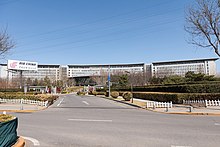

The entity Air China Limited was registered in 2003, and its shares began trading in Hong Kong and London on 15 December 2004. Originally the airline corporate entity was Air China International, which was founded 2002 Air China International incorporated China Southwest Airlines and the air transportation services of the China National Aviation Corporation, becoming a new entity.[19]
The Air China HQ Building (国航总部大楼; 國航總部大樓; Guó Háng Zǒngbù Dàlóu), the corporate headquarters, is located in Zone A of the Tianzhu Airport Industrial Zone (天竺空港工业区; 天竺空港工業區; Tiānzhú Kōng Gǎng Gōngyèqū) in Shunyi District, Beijing.[19][20][21] The company registered office is on the ninth floor of the Blue Sky Mansion (蓝天大厦; 藍天大廈; Lántiān Dàshà), also in Zone A of the Tianzhu Airport Industrial Zone.[22]
The enterprise logo of Air China consists of an artistic Fenghuang pattern, the name of the airline written in calligraphy by former national leader Deng Xiaoping, and "AIR CHINA" in English. The phoenix logo is also the artistic transfiguration of the word "VIP". Air China is a member of the Star Alliance.
Air China is primarily based in its hub of Beijing Capital International Airport (IATA: PEK), where it operates numerous long-range aircraft on routes to North America, Europe, South America, Africa and Australia. Its fleet is made up of an assortment of Boeing and Airbus aircraft, including: Boeing 737s, 747s, 777s, 787s along with Airbus A319s, A320s, A321s and A330s. Air China also operates hubs in Chengdu Shuangliu International Airport, where it primarily flies domestic routes, as well as Shanghai Pudong International Airport, from which many international routes are served.[citation needed]
Ownership structure
[edit]| [23] | Owner | Percentage of shares held |
| 1 | Aviation Corporation of China | 40.53 |
| 2 | Cathay Pacific | 16.26 |
| 3 | Hong Kong Securities Clearing Company | 10.43 |
| 4 | Aviation Corporation of China | 9.61 |
| 5 | China Securities Finance Corporation | 1.92 |
| 6 | Aviation Fuel Group of China | 1.47 |
| 7 | Hong Kong Securities Clearing Company | 0.97 |
| 8 | China State-owned Enterprises Structural Adjustment Fund | 0.41 |
| 9 | China Basic pension fund | 0.36 |
| 10 | China Merchants Anhua Bond Fund | 0.31 |
Destinations
[edit]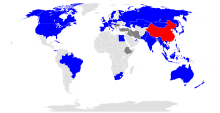


Air China's route network extends throughout Asia to the Middle East, Western Europe, and North America from its hubs at Beijing Capital International Airport and Chengdu Tianfu International Airport.[24] It also currently reaches a significant number of Asian, Australian and European destinations from Shanghai. Some international routes operate from Chengdu, Chongqing, Dalian, Hangzhou, Kunming and Shenzhen. It is one of the few world airlines that fly to all six habitable continents.
On 10 December 2006, Air China began serving its first South American destination, São Paulo-Guarulhos (via Madrid-Barajas). This is the airline's longest direct flight.[25] The service was initiated with a Boeing 767-300ER, but due to increased demand, the service has been upgraded to an Airbus A330-200, and later a Boeing 787-9.
Regular flights between mainland China and Taiwan started in July 2009. Due to the political status of Taiwan, all Air China airframes that operate flights to and from Taiwan are required to cover the flag of the People's Republic of China on the fuselage.[citation needed]
Air China introduced its new Airbus A330-300 to long-haul operations beginning with services to Düsseldorf, Germany in summer 2011. These aircraft provided the same two-class cabin standard as the Airbus A330-200 except that the economy cabin had no seat-back entertainment system installed (with the exception of the first two economy rows which also had increased legroom). Düsseldorf is now the third German destination on the Air China network. The airline launched a new Beijing-Milan-Malpensa service on 15 June 2011, complementing the airline's existing service to Milan from Shanghai.
Deliveries of the carrier's 19 new Boeing 777-300ERs commenced in mid-2011, with the aircraft forming the new "backbone of its future longhaul operations." The new Boeing 777-300ERs replaced the Boeing 747-400s on routes to U.S. destinations such as Los Angeles, New York, and San Francisco, but was expected to first enter service on flights to Paris from March 2012. The Boeing 777-300ER began to replace most 747 service once sufficient numbers entered the fleet.[26] Air China expanded its operations in India with a Beijing-Mumbai route begun in September 2011, while the existing Delhi route was upgraded to the A330.[27] The airline also launched service to Mumbai from Chengdu on 2 May 2012.[28] The airline began using the Boeing 777-300ER on one of its two daily Beijing-Los Angeles flights on 1 February 2012.[29] In the late-2012's to early 2013's, the airline replaced the Boeing 747-400s servicing the New York and San Francisco routes with the Boeing 777-300ER.[30] With the addition of the Boeing 777-300ERs on the US routes, Air China increased frequency on the Beijing-New York route, changing the flights from 7 to 11 flights a week by adding two new flights to the route (CA989/990).[31] On 21 January 2014, the airline launched its service to Hawaii with flights from Beijing to Honolulu, the first nonstop flights between the two cities.[32] The airline also increased the frequency of service on the Beijing-Houston Intercontinental route from four times weekly to daily service from 30 March 2014.[33] Beginning 10 June 2014, Air China introduced new nonstop service from Beijing to Washington-Dulles, operated by a Boeing 777-300ER.[34] As of 29 September 2015, Air China also introduced a three times weekly flight to Montréal–Pierre Elliott Trudeau International Airport in a codeshare with Air Canada.[35] The Montreal flight was extended to Havana from 27 December 2015.
Air China started its direct flights to Johannesburg, South Africa from 29 October 2015.[36]
Codeshare agreements
[edit]Air China codeshares with the following airlines:[37]
- Air Canada (Joint Venture Partner)
- Air Dolomiti
- Air India
- Air Macau
- Air New Zealand
- Air Serbia
- All Nippon Airways
- Asiana Airlines
- Austrian Airlines
- Avianca
- Cathay Pacific
- China Express Airlines
- Egyptair[38]
- El Al
- Ethiopian Airlines
- EVA Air
- Finnair
- Hawaiian Airlines
- Juneyao Air
- Kunming Airlines
- LATAM Brasil
- LATAM Chile
- LOT Polish Airlines
- Lufthansa
- Scandinavian Airlines
- Shandong Airlines
- Shenzhen Airlines
- Singapore Airlines
- South African Airways
- Swiss International Air Lines
- TAP Air Portugal
- Tibet Airlines
- Turkish Airlines
- Uni Air
- United Airlines
- Virgin Atlantic
- WestJet
Interline agreements
[edit]Air China has Interline agreements with the following airlines:[39]
Fleet
[edit]Current fleet
[edit]As of January 2025[update], Air China operates the following aircraft:[40][41]
| Aircraft | In service | Orders | Passengers | Notes | ||||
|---|---|---|---|---|---|---|---|---|
| F | B | E+ | E | Total | ||||
| Airbus A319 | 27 | — | — | 8 | — | 120 | 128 | |
| Airbus A320 | 38 | — | — | 8 | — | 150 | 158 | |
| Airbus A320neo | 53 | 23[42][43] | — | 8 | — | 150 | 158 | [44] |
| Airbus A321 | 61 | — | — | 16 | — | 161 | 177 | |
| 12 | 173 | 185 | ||||||
| Airbus A321neo | 30 | 45[43] | — | 12 | — | 182 | 194 | [44] |
| 186 | 198 | |||||||
| Airbus A330-200 | 19 | — | — | 30 | — | 207 | 237 | |
| 18 | 247 | 265 | ||||||
| 12 | 271 | 283 | ||||||
| Airbus A330-300 | 28 | — | — | 30 | 16 | 255 | 301 | |
| 36 | 20 | 311 | ||||||
| Airbus A350-900 | 30 | — | — | 32 | 24 | 256 | 312[45] | Has two different Business Class seats. [46] |
| Boeing 737-700 | 18 | — | — | 8 | — | 120 | 128 | |
| Boeing 737-800 | 87 | — | — | 8 | — | 159 | 167 | |
| 168 | 176 | |||||||
| 12 | 147 | 159 | ||||||
| Boeing 737 MAX 8 | 24 | — | — | 8 | — | 168 | 176 | |
| Boeing 747-400 | 2 | — | 10 | 42 | — | 292 | 344 | |
| Boeing 747-8I | 7 | — | 12 | 54 | 66 | 233 | 365[47] | B-2479 used for VIP transport. |
| Boeing 777-300ER | 28 | — | 8 | 42 | — | 261 | 311 | |
| — | 36 | 356 | 392[48] | |||||
| Boeing 787-9 | 14 | — | — | 30 | 34 | 229 | 293[49] | |
| Comac C909 | 33 | 2[50] | — | — | — | 90 | 90 | Deliveries until 2024. |
| Comac C919 | 3 | 102 | — | 8 | — | 150 | 158 | Deliveries from August 2024 until 2031.[51][52] |
| Air China Business Jets fleet | ||||||||
| Boeing BBJ1 | 1 | — | VIP | Operated by Beijing Airlines. | ||||
| Boeing BBJ2 | 3 | — | VIP | |||||
| Dassault Falcon 7X | 1 | — | VIP | |||||
| Total | 507 | 172 | ||||||
Former fleet
[edit]| Aircraft | Total | Introduced | Retired | Notes |
|---|---|---|---|---|
| Airbus A340-300 | 6 | 1997 | 2014 | |
| Boeing 707-320 | 6 | 1988 | 1993 | |
| Boeing 737-200 | 4 | 1988 | 1995 | Disposed to Air Great Wall. |
| Boeing 737-300 | 44 | 1988 | 2014 | |
| Boeing 737-600 | 6 | 2003 | 2009 | |
| Boeing 747-200M | 3 | 1988 | 2000 | Converted into freighters and transferred to Air China Cargo. |
| Boeing 747-400M | 4 | 1989 | 2013 | |
| 3 | Converted into freighters and transferred to Air China Cargo. | |||
| Boeing 747SP | 4 | 1988 | 2000 | |
| Boeing 757-200 | 9 | 2003 | 2010 | Converted into freighters and disposed to SF Airlines. |
| 4 | Converted into freighters and transferred to Air China Cargo. | |||
| Boeing 767-200ER | 5 | 1988 | 2009 | |
| 1 | 2002 | Crashed as flight CA129. | ||
| Boeing 767-300 | 4 | 1993 | 2012 | |
| Boeing 767-300ER | 5 | 2003 | 2012 | |
| Boeing 777-200 | 10 | 1998 | 2018 | |
| BAe 146-100 | 4 | 1988 | 2008 | |
| Gulfstream IV | 1 | Unknown | Unknown | Used for VIP flights. |
| Hawker Siddeley Trident | 3 | 1988 | 1991 | |
| Learjet 45 | 1 | 2004 | 2007 | Used for VIP flights. |
| Lockheed L-100 Hercules | Unknown | Unknown | Unknown | |
| Xian Y-7 | 3 | 1988 | 1996 |
Air China Cargo
[edit]Air China Cargo, is a subsidiary of Air China, that focuses on freight delivery and does not transport passengers. It operates routes across Asia, Europe and North America with its fleet of Boeing 747-400Fs, Boeing 757-200PCF and Boeing 777F.
Accidents and incidents
[edit]- On 15 April 2002, Air China Flight 129, a Boeing 767-200ER from Beijing to Busan, South Korea, crashed into a hill while trying to land at Gimhae International Airport during inclement weather, killing 129 of the 166 people on board.[53][54] This is Air China's only fatal accident to date.
- On 15 March 2003, Air China Flight 112, operated by a Boeing 737-36N carried a 72 year old man infected with SARS. The infection later transmitted to 20 other passengers during the flight, causing five of them to later die from SARS. It was the largest in-flight super-spread transmission of SARS during the 2003 SARS epidemic.[citation needed]
- On 27 August 2019, Air China Flight 183, an Airbus A330-343X from Beijing to Tokyo, Japan, was damaged beyond repair due to a cargo fire while on the ground at Beijing just shortly before departure. No one was injured.[55][56]
- On 10 September 2023, Air China Flight 403, operated by an Airbus A320neo (B-305J) from Chengdu Tianfu International Airport to Singapore Changi Airport, had a fire in its left engine right before landing. The plane landed safely at its destination at 4.15pm with all 155 passengers and crew members[57] safely evacuated via the emergency slides. Nine passengers sustained minor injuries related to smoke inhalation and abrasions during the evacuation.[58][59][60][61]
Controversy
[edit]Air China's inflight magazine Wings of China faced accusations of racism when they stated "London is generally a safe place to travel, however precautions are needed when entering areas mainly populated by Indians, Pakistanis, and black people." in their September 2016 issue.[62][63] On 8 September 2016, Air China issued an apology.[64] Air China Media, which publishes the Wings of China magazine, said it wished to apologise to "readers and passengers who are feeling uncomfortable".[65] It added: "This invariably inappropriate description... was purely a work mistake by the editors and it's not the magazine's views...We will immediately recall this entire issue of magazines and draw lessons from this incident."[66][67]
Despite the international sanctions imposed on Russia due to its ongoing invasion of Ukraine, Air China continues to operate flights to and from Russia.[68] This strategy has bolstered its dominance in the China-Europe market but has drawn criticism for indirectly supporting Russia's economy during its military aggression in Ukraine. Some believe Air China's ongoing operations to Russia disregard the ethical implications of the conflict, prioritizing profits over solidarity with international sanctions aimed at curbing Russia's actions.[68][69][70]
See also
[edit]- Aviation industry in the People's Republic of China
- List of airlines of the People's Republic of China
- List of airports in the People's Republic of China
- List of companies of the People's Republic of China
- Transportation in the People's Republic of China
Notes
[edit]References
[edit]- ^ "Air China 2017 Annual Report". Air China. 2011.
- ^ "Air China on ch-aviation". ch-aviation. Retrieved 9 November 2023.
- ^ "Air China Annual Report 2017" (PDF). Retrieved 5 November 2018.
- ^ CAAC becomes Air China Australian Aviation issue 46 September 1988 page 15
- ^ "Directory: World Airlines". Flight International. 27 March 2007. p. 55.
- ^ Ng, Eric, "Air China Set to Announce Lead Bank for Listing," South China Morning Post, Bus. Sec., 16 July 2001, p. 4.
- ^ Holland, Tom, "China Break-In," Far Eastern Economic Review, 25 October 2001, p. 41.
- ^ "Air China plans to buy 15 new planes". Seattle Post-Intelligencer. Associated Press. 30 October 2002. Archived from the original on 9 October 2012. Retrieved 6 February 2011.
- ^ Air China increases stake in Air Macau to almost 81% Archived 13 December 2009 at the Wayback Machine, Air Transport Intelligence news, 12.07.2010
- ^ Air China to Raise Cathay Pacific Stake to 30% (Update2) Archived 2012-11-04 at the Wayback Machine, Bloomberg News 17 August 2009
- ^ Air China acquires majority stake in Shenzhen Airlines Archived 25 April 2011 at the Wayback Machine, Air Transport Intelligence news, 22/03/10
- ^ Air China Received Top Tourism Award TN Global Travel Industry News, 3 Dec 2010
- ^ "air china launches flight shuttle bus combined ticket for domestic routes". Antara News. Archived from the original on 4 April 2016. Retrieved 23 February 2015.
- ^ Chen, Andrea (17 April 2014). "Broadband browsing at 32,000 feet: Air China introduces new fast internet service". South China Morning Post. South China Morning Post Publishers Limited. Retrieved 8 September 2016.
- ^ "Air China starts free Wi-Fi service on flights, but not for mobile phones". Skift. 4 July 2013. Retrieved 24 May 2019.
- ^ Wadman, Meredith. "Air China won't fly research primates". Nature. Archived from the original on 4 April 2015. Retrieved 28 January 2015.
- ^ 国内航班首试空中上网服务_中国经济网――国家经济门户 (in Chinese (China)). China Economic Net. Archived from the original on 29 June 2016. Retrieved 8 September 2016.
- ^ "Air China". Airliner World: 17. March 2015.
- ^ a b "Corporate Social Responsibility Report 2010." (Archive) Air China. p. 7. Retrieved on 12 October 2012. "Headquarter location No. 30, Tianzhu Road, Tianzhu Airport Industrial Zone, Beijing, China"
- ^ "Membership Archived 29 September 2012 at the Wayback Machine." (Archive) IATA. Retrieved on 12 October 2012. "Air China Limited West 6th Floor Air China HQ Building No 30 Tianzhu Road Tianzhu Airport Economic Development Zone Beijing China (People's Republic of) 100621"
- ^ 联系我们 (in Chinese (China)). Air China. Archived from the original on 13 October 2012. Retrieved 12 October 2012.
北京市顺义区天竺空港经济开发区天柱路30号国航总部大楼E410房间
- ^ "Interim Report 2012." (Archive) Air China. Retrieved on 12 October 2012. "The registered office of the Company is located at 9th Floor, Blue Sky Mansion, 28 Tianzhu Road, Zone A, Tianzhu Airport Industrial Zone, Shunyi District, Beijing 101312, the PRC."
- ^ "中国国航(601111)主要股东_新浪财经_新浪网". vip.stock.finance.sina.com.cn. Retrieved 23 February 2024.
- ^ "Hainan Airlines set to establish Chengdu base". ch-aviation. 22 January 2017. Retrieved 23 January 2017.
- ^ "History of Air China". SeatMaestro. Retrieved 27 May 2019.
- ^ "Air China Expands With Second Daily Nonstop Flight From Los Angeles to Beijing". PR Newswire. 12 January 2011. Retrieved 30 June 2013.
- ^ "Air China expands India operations". Business Standard India. Business-standard.com. 1 July 2011. Retrieved 17 October 2011.
- ^ [1][dead link]
- ^ [2][dead link]
- ^ Christine Boynton (19 January 2012). "Air China begins replacing 747s with 777s on US routes". ATWOnline. Retrieved 30 June 2013.
- ^ "New York to Beijing routes increased from one flight to two flights per day". 4 April 2013.
- ^ "Air China commences new route". Archived from the original on 19 February 2014. Retrieved 23 January 2014.
- ^ Houston Airport System (14 January 2014). "Air China Expands Nonstop Houston-Beijing Service To Daily" (Press release). Retrieved 24 April 2015.
- ^ "Air China to Commence Beijing-Washington Nonstop Service". Wall Street Journal. Retrieved 24 April 2015.
- ^ "Air China to Launch Beijing-Montreal Flights in Cooperation with Air Canada". newswire.ca. Archived from the original on 31 May 2015. Retrieved 28 May 2015.
- ^ "Air China puts direct route to SA on hold". News24. 29 May 2015. Archived from the original on 13 May 2016. Retrieved 9 April 2019.
- ^ "Profile on Air China". CAPA. Centre for Aviation. Archived from the original on 29 October 2016. Retrieved 29 October 2016.
- ^ "Air China resumes Egyptair codeshare from early-June 2024". aeroroutes.com. 26 June 2024.
- ^ "INTERLINE AND CODESHARE TRAVEL". Pakistan International Airlines.
- ^ Air China - Aircraft Information Airchina.com Retrieved 2016-11-23
- ^ "Air China Fleet in Planelogger.com". Planelogger.com. Retrieved 28 June 2020.
- ^ 27 May 2013. "Air China orders 100 Airbus A320 planes". cargonewsasia.com. Archived from the original on 22 September 2013. Retrieved 22 September 2013.
{{cite web}}: CS1 maint: numeric names: authors list (link) - ^ a b "Aircraft orders in 2022". Airbus. Retrieved 4 December 2022.
- ^ a b "Air China to acquire five A320neo, 13 A321neo". Ch-Aviation. 21 March 2021.
- ^ "Air China to take first A350 in early August". atwonline.com. Retrieved 18 July 2018.
- ^ "Archived copy". New York Times. Archived from the original on 11 July 2019. Retrieved 11 July 2019.
{{cite web}}: CS1 maint: archived copy as title (link) - ^ Shih, Kai-Chin (30 September 2014). "Air China Boeing 747-8I Interior Information". >talkairlines. Archived from the original on 18 April 2019. Retrieved 30 September 2014.
- ^ "Air China begins 2-class 777 service from Dec 2016". routesonline.com. Archived from the original on 3 November 2016. Retrieved 1 October 2016.
- ^ "Air China Files Preliminary Boeing 787-9 Operational Routes in S16". 2016. Retrieved 8 September 2016.
- ^ "Air China orders 35 domestically-built ARJ21s". flightglobal.com. Retrieved 30 August 2019.
- ^ "国航、南航今同时接收首架中国国产C919 各订100架". Lianhe Zaobao (in Simplified Chinese). Retrieved 28 August 2024.
- ^ "Air China orders 100 C919s with extended range". Ch-Aviation. Retrieved 28 April 2024.
- ^ The Evil Queen (15 April 2002). "Chinese jet hits foggy mountain - World News". TVNZ. Retrieved 30 June 2013.
- ^ "ASN Aircraft accident Boeing 767-2J6ER B-2552 Pusan-Kimhae Airport (PUS)". Aviation-safety.net. Retrieved 30 June 2013.
- ^ "Air China plane catches fire as crew prepare to board passengers". independent.co.uk. 27 August 2019. Retrieved 12 April 2024.
- ^ Simon Hradecky. "Accident: Air China A333 at Beijing on Aug 27th 2019, aircraft on fire at the gate". avherald.com. The Aviation Herald. Retrieved 12 April 2024.
- ^ Ranter, Harro. "Serious incident Airbus A320-271N B-305J, Sunday 10 September 2023". asn.flightsafety.org. Retrieved 4 January 2025.
- ^ "Air China plane lands safely at Changi Airport after engine catches fire; one runway closed". Elaine Lee. 10 September 2023. Retrieved 10 September 2023.
- ^ "Air China flight lands in Singapore after detecting smoke; all passengers safe". 10 September 2023. Retrieved 10 September 2023.
- ^ "Changi Airport temporarily closes runway after Air China flight catches fire". 10 September 2023. Retrieved 10 September 2023.
- ^ "Air China plane makes emergency landing at Changi Airport after engine catches fire". Ashley Tan. 10 September 2023. Retrieved 10 September 2023.
- ^ "Chinese airline sparks row with 'racist' travel guide to London". The Independent. 7 September 2016. Archived from the original on 8 September 2016. Retrieved 13 January 2020.
- ^ "Air China Under Fire For 'Racist' Warning On London Minority Areas". 7 September 2016. Retrieved 8 September 2016.
- ^ Oppenheim, Maya (11 September 2016). "Sadiq Khan has condemned Air China's 'racist' London tour guide". The Independent. Archived from the original on 12 September 2016. Retrieved 13 January 2020.
- ^ "Air China magazine apologises for London race slur". BBC News. 8 September 2016. Retrieved 8 September 2016.
- ^ Wong, Edward (7 September 2016). "Air China Will Fly You to London, and Warn You About Dark-Skinned People There". The New York Times. ISSN 0362-4331. Retrieved 13 January 2020.
- ^ Travel tip to London from Air China accused of racism, 8 September 2016, archived from the original on 9 November 2021, retrieved 13 January 2020
- ^ a b "Flying over Russia: Chinese airlines win and Europeans lose". POLITICO. 10 December 2024. Retrieved 10 December 2024.
- ^ Hirschfeld, Andy. "As Ukraine, Gaza wars rage on, some airlines are benefitting". Al Jazeera. Retrieved 10 December 2024.
- ^ Xiaofei, Xu (25 April 2023). "Russia's war on Ukraine redrew the map of the sky – but not for Chinese airlines". CNN. Retrieved 10 December 2024.
External links
[edit]- Official website
- Business data for Air China:
- Air China
- Companies formerly in the Hang Seng China Enterprises Index
- Companies listed on the Hong Kong Stock Exchange
- Companies listed on the London Stock Exchange
- Companies listed on the Shanghai Stock Exchange
- Companies in the CSI 100 Index
- Airlines of China
- Airlines established in 1988
- Chinese companies established in 1988
- 2004 initial public offerings
- Government-owned companies of China
- Airlines based in Beijing
- Chinese brands
- Star Alliance
- H shares
- Shunyi District
- 1988 in Beijing

